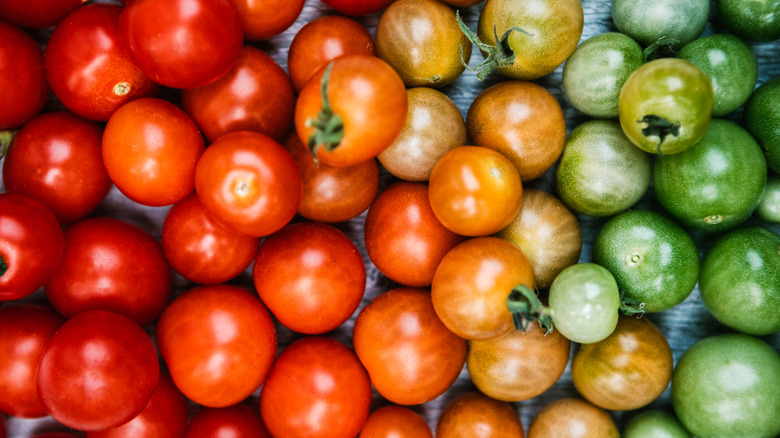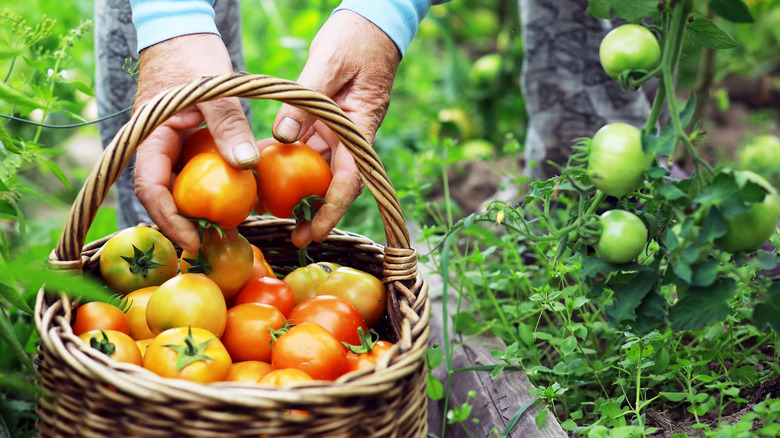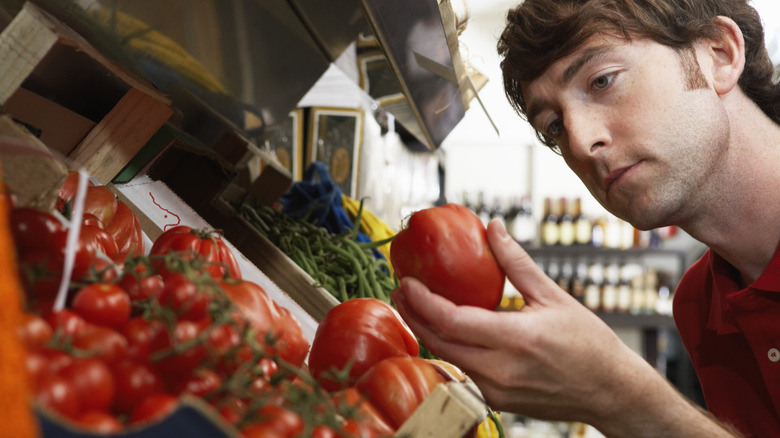Ripen Tomatoes Quicker Than Ever With One Simple Hack
Nothing says summer quite like a perfectly ripe tomato. Unfortunately, the window of time for picking the ripest tomatoes possible, unless you're growing them yourself, is quite short. If you're buying from the grocery store, it's still possible to get that deeply flavored, sweet and savory, juicy tomato you're dreaming of — it just takes a little patience and scientific know-how, plus a particular tropical fruit.
There are a lot of myths about tomato ripening that have been debunked in recent years, even if they still persist and are deeply held. One of the biggest is that tomatoes only ripen on the vine. Recent research and testing have proven that this isn't the case; tomatoes can ripen off the vine with seemingly no detriment to their integrity off the vine. And with a few changes to how you store them, you can control the ripening speed yourself at home. The storage hack require a warm (85 degrees Fahrenheit, optimally) place, a breathable container (a paper bag, for example), and of course, a banana.
How to ripen tomatoes with science
Let's address the elephant in the room: The banana. Unless you're aware of this method, that might have caught you off guard.
When fruit ripens, it produces a natural gas called ethylene. In fruits that can ripen off the vine (called climacteric fruits), a group in which we now know tomatoes are included, ethylene is an autocatalyzer — an initial concentration of ethylene urges the fruit to produce more of the gas, which causes the fruit to ripen. More ethylene equals more ripening. Compared to other fruits, bananas have some of the highest ethylene levels. Hence, a banana in a bag with an apple, avocado, pear, or tomato will actually accelerate ripening. This is also why you want a breathable container; you want to trap the ethylene gas without creating a stagnant environment in which the food will go anaerobic.
The temperature is also important and will affect the speed at which your tomatoes ripen. You obviously don't want to get anywhere near freezing, because the delicate cells of the fruit will rupture upon thawing (ice crystals are brutal). The lowest you should go in temperature range is 55 degrees Fahrenheit. That will slow down the pace of ripening without damaging the fruit. To speed up ripening, the ideal temperature is 85 degrees Fahrenheit. This is where the myth that tomatoes need a sunny window comes from — it's not necessarily just about the sun.
Tomato myths
Tomatoes really have an inordinate amount of associated myths, starting with the belief that they were poisonous. For a long time, they were also thought to be incapable of off-the-vine ripening. What was found, upon studying the epigenetics of tomatoes, is that young tomatoes with immature seeds don't ripen in response to ethylene — but once tomatoes have matured enough on the vine to go through a DNA revamp, ethylene can trigger ripening. As long as tomatoes reach this stage — "color break," when the tomato starts to change color — they can ripen off the vine.
So what about this sunlight thing? Sure, plenty of blogs will tell you to put the tomato in a sunny window, but it's a red herring. It's been proven that yes, green tomatoes do photosynthesize through their flesh, but this is heavily decreased after the tomato turns red. If you've picked up a hard, pink tomato from the grocery store, it won't really photosynthesize. It's the temperature difference that is key. If the average climate-controlled house is going to be somewhere around 68 to 76 degrees, the bump from a sunny window will bring it within the ideal ripening temperature of 85 degrees. It's the warmth, not the sunlight, that does much of the work here.
One final tip for this hack is to ripen the tomato on its shoulders to keep it from getting soft and mushy on the bottom. No one wants a mushy tomato, no matter how ripe it is.


